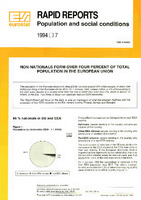RAPID REPORTS Population and social conditions. THE POPULATION OF THE EUROPEAN ECONOMIC AREA IN 1992. 1993.7
| dc.contributor.author | Eurostat |
| dc.date.accessioned | 2020-10-16T06:43:15Z |
| dc.date.available | 2020-10-16T06:43:15Z |
| dc.date.issued | 1994-07 |
| dc.identifier.issn | 1016-0205 |
| dc.identifier.uri | https://ketlib.lib.unipi.gr/xmlui/handle/ket/2938 |
| dc.description | http://aei.pitt.edu/id/eprint/87531 |
| dc.description.abstract | The population in the European Economic Area (EEA) numbers around 370 million people, of whom 344 million are living in the European Union (EU). On 1 January 1992, sixteen million or 4% oí those living in the EEA were citizens of a country other than the one in which they lived (also 4%, which is almost 15 million, in the EU). Two thirds of these non-nationals had non-EEA citizenship. This Rapid Report will focus on the EEA, to give an impression of what the situation might be with the accession of four EEA countries to the EU, namely Austria, Finland, Norway and Sweden |
| dc.format.extent | 12p. |
| dc.language.iso | en |
| dc.publisher | Eurostat |
| dc.subject | Social conditions |
| dc.title | RAPID REPORTS Population and social conditions. THE POPULATION OF THE EUROPEAN ECONOMIC AREA IN 1992. 1993.7 |
| dc.type | working document |
| dc.publisher.place | Luxemburg |

